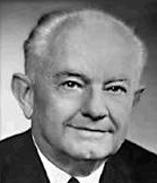Ernest Holmes
(January 21, 1887 – April 7, 1960)
About New Thought Author Ernest Holmes
Ernest Holmes was an American spiritual and New Thought writer, teacher, and leader.
He was the founder of a Spiritual movement known as Religious Science, a part of the greater New Thought movement, whose spiritual philosophy is known as "The Science of Mind."
Ernest Shurtleff Holmes was born on a small farm in Lincoln, Maine. His family was poor and Ernest was the youngest of nine sons. As a teenager, he attended Bethel preparatory school, but he spent a majority of his time outdoors pondering spiritual matters. At the age of fifteen, Ernest left school and his home in Maine and headed to Boston, Massachusetts. From 1908 to 1910, he got a job as a store clerk to pay for his tuition at the Leland Powers School of Expression which he attended in Boston. It was there that Ernest was introduced to Mary Baker Eddy's Science and Health textbook, as well as the teachings of Christian Science.
In 1912, Holmes joined his brother Fenwicke Holmes in Venice, California. He took a job working with the city government, and along with his brother, became a Congregationalist minister. As his metaphysical interests and studies grew, his quest for truth lead him to art, science, literature, philosophy, and religion.
Holmes began to study the writings of the great New Thought authors of the time, such as Thomas Troward, Ralph Waldo Emerson, Christian D. Larson, Phineas P. Quimby, and William Walker Atkinson.
In 1914, at the age of 25, Ernest moved to Venice, California and continued to pursue his studies. He was most influenced by the writings of Thomas Troward at this time, and began teaching Troward's ideas and principles to small groups. Holmes was later ordained as a minister of the Divine Science church.
Holmes continued to minister and speak at several small meetings throughout the city. In 1916, he wasinvited to speak at the Metaphysical Library in Los Angeles.This paved the way for even more speaking opportunities, and eventually he set out on a nationwide tour. In 1919, Ernest Holmes published his first book, The Creative Mind. After almost a decade of touring, Holmes decided to remain in the Los Angeles area in order to complete his major work, The Science of Mind, which he published in 1926.
Also in 1926, Holmes started to speak each Sunday morning in a theatre in the the Ambassador Hotel that seated 625 people. Holmes lectures continued to draw larger and larger crowds, requiring larger spaces. Holmes continued moving to larger spaces to accomodate the growing audiences, including the Biltmore Hotel, and the Wiltern Theatre. In February of 1927, Holmes incorporated the Institute of Religious Science and School of Philosophy, Inc. Later that same year, he began the publication his Science of Mind magazine. Later, Holmes would reincorporate his organization as the Institute of Religious Science and Philosophy.
In the 1920s, Holmes published his famous statement of beliefs.
Throughout his research, Ernest Holmes created a "structure of concepts" based on the major religions and philosophies of human history, sometimes even correlating his finding with the then-emerging "new" physics. He named his teaching a science because he believed that its principles were scientifically provable in practice. Holmes, like many other great minds in the New Thought and Spiritual movements of the time, believed strongly that there was a "Golden thread of truth" that ran through all of the world's religions, as well as in science and philosophy.
Ernest Holmes was widely recognized for his work. In 1945, he was awarded the honorary degree of 'Doctor of Philosophy' by Andhra University in India. The California College of Medicine, University of California at Irvine awarded him a 'Doctor of Humane Letters', and the Foundation Academic University of Spiritual Understanding in Venice, Italy, awarded him a 'Doctor of Letters'. In 1942, Ernest Holmes was also bestowed with the 'Cross of the Commander of the Grand Humanitarian Prize of Belgium', and in 1944, Holmes was named honorary member of the Eugene Field Society.
In 1954, Holmes Institute was again re-established as a religious organization called the Church of Religious Science.; in 1967, it was given its present-day title, United Church of Religious Science.
In 1927, Ernest married Hazel Durkee Foster, who was a widow. They had no children, but were inseprable companions for over thirty years.
Ernest Holmes wife, Hazel passed away on May 21, 1957. Ernest Holmes would pass away three years later.
Today, Ernest Holme's Science of Mind and Religious Science teachings are continued by the Centers for Spiritual Living, the Affiliated New Thought Network, and the Global Religious Science Ministries, several independent Religious Science ministries, and other organizations.
Ernest Holmes was one of the greatest minds of his time and is still widely popular today. His Science of Mind teaching is still recognized as one of the leading viewpoints in modern metaphysics.
His books remain in print, and the principles he taught as "Science of Mind" have inspired and influenced many generations of metaphysical students and teachers.
Resources:
A Guide for Spiritual Living Science of Mind
Ernest Holmes.net
Science of Mind Archieves - Ernest Holmes
Science of Mind Archieves - Ernest Holmes
Holmes Institute - School of Consciousness Studies
Quotes by Ernest Holmes
<< Previous Page
Next Page>>
